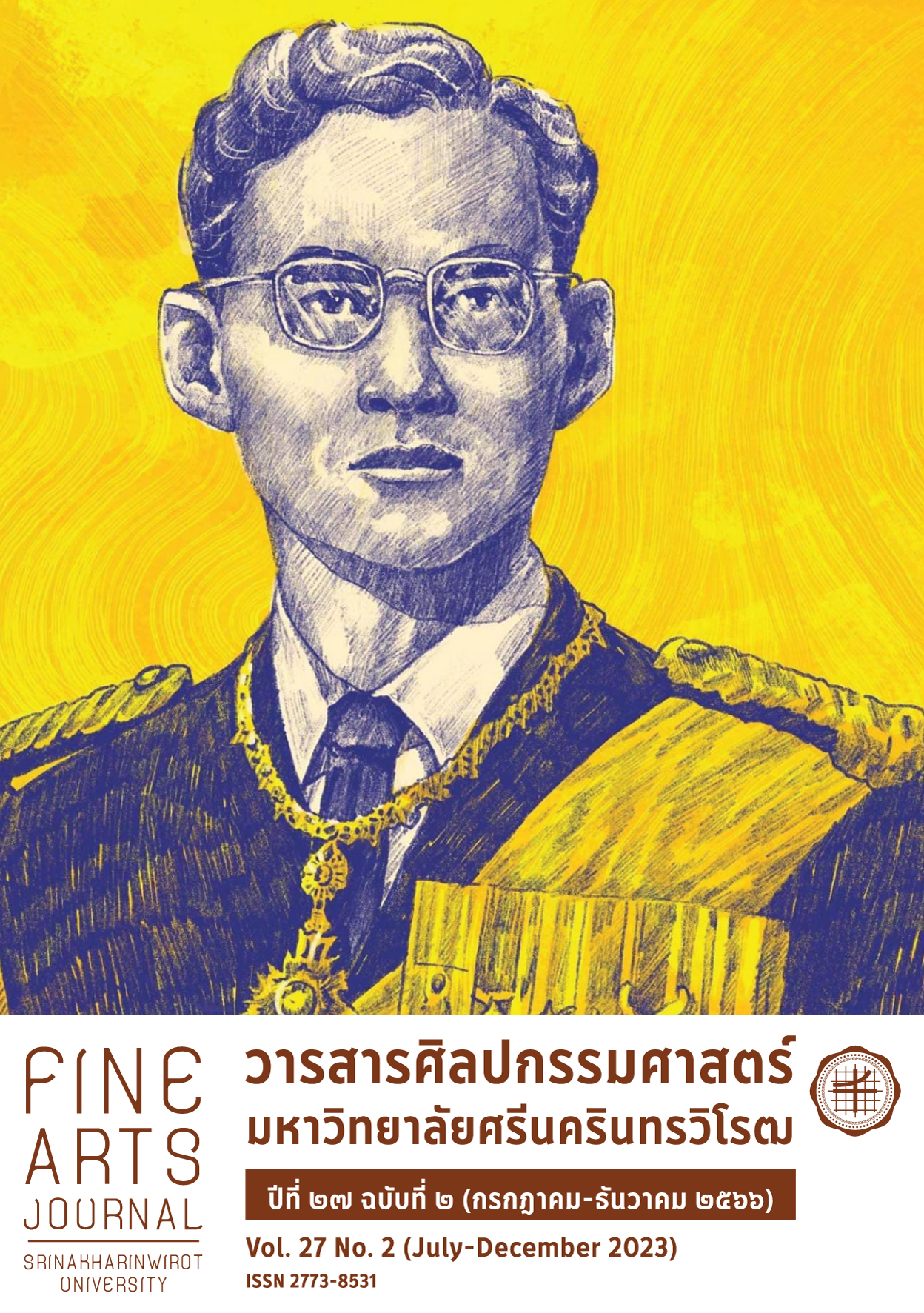THE CREATION OF TOURMALINE SCRAPS FOR MAKING JEWELRY
Keywords:
Tourmaline Scraps, Shape Cutting Process, JewelryAbstract
The purposes of this research are 1) to create guidelines for the creation of tourmaline scraps from shape cutting process to develop jewelry styles, 2) to transfer the knowledge on the creation of tourmaline scraps from the cutting process to gems and jewelry entrepreneurs from the group of the community enterprise gems and jewelry Chanthaburi province. In this research, the scamper technique was applied using the creative process. The scamper technique is the technique that combines modern materials with local materials (gems scraps) in the design process. The gem scraps in this research were pink and green color tourmaline scraps from the shape-cutting process of making shapes and removing cracks. The gem from that process would become smooth and flat with different thicknesses, transparent, and translucent. The creation was divided into two groups: the first group was thin tourmaline scraps. In this group, the scraps would be designed for mosaic work by applying polymer clay as a soldering material and coating gems with UV resin to make a glossy appearance and protect gemstones from falling off. The second group was thick tourmaline scraps. In this group, the scraps would be processed in shapes with epoxy resin in the casting process. The epoxy resin was chosen because of its dry quality which made scraps more beautiful and brighter. Afterward, the knowledge was transferred to gem and jewelry entrepreneurs to produce the jewelry prototype to increase its value. The processed scraps with resin were an option, and it could create the business opportunities to maximize the values of tourmaline scraps.
Downloads
References
กฤษณะ เวชพร. (2548). อัญมณีวิทยา. เชียงใหม่. นพรัตน์การพิมพ์.
ตวงรัก รัตนพันธุ์, และชัชวาลย์ รัตนพันธุ์. (2560). การออกแบบของที่ระลึก: การประยุกต์ใช้ภูมิปัญญาท้องถิ่นสู่
ผลิตภัณฑ์ชุมชน. วารสารนาคบุตรปริทรรศน์, 9(1), 1-14.
ธนกฤต ใจสุดา, และรัศมน ทองงามขำ. (2564). การออกแบบเครื่องประดับเซรามิกโบนไซน่า. วารสารศิลปกรรมศาสตร์
มหาวิทยาลัยศรีนครินทรวิโรฒ, 25(1), 35-54.
พรพิมล พจนาพิมล. (2561). การศึกษาแนวโน้มการออกแบบเครื่องประดับในศตวรรษ 21 เพื่อสร้างมูลค่าเพิ่มให้กับหิน
ดิบด้วยกระบวนการออกแบบ. วารสารวิชาการนวัตกรรมสื่อสารสังคม, 6(2), 181-193.
ภัทรบดี พิมพ์กิ, ภัทรา ศรีสุโข, ศันสนีย์ อาจนาฝาย, สิริวิภา วิมุกตายน และกรกนก สนิทการ. (2565). การสร้างสรรค์
เครื่องประดับจากเสื่อกกจันทบูร จังหวัดจันทบุรี. วารสารชุมชนวิจัย, 16(2), 70-82.
ศูนย์ข้อมูลอัญมณีและเครื่องประดับ. (2564ข, ธันวาคม 3). อัญมณีและเครื่องประดับรักษ์โลก เทรนด์ใหม่ ผู้บริโภคใสใจ
สิ่งแวดล้อม. สืบค้นเมื่อ 15 พฤษภาคม 2565 จาก https://infocenter.git.or.th/storage/files/3QrgGDZb2lMEQc97lF62O7KocBGHaXHkZJnSiFIE.pdf
ศูนย์ข้อมูลอัญมณีและเครื่องประดับ. (2564ก, ธันวาคม 29). Eco-Friendly Jewelry ทางเลือกใหม่ใส่ใจสิ่งแวดล้อม.
สืบค้นเมื่อ 15 พฤษภาคม 2565 จาก https://infocenter.git.or.th/storage/files/XPISTjaPt4Wox3lVhFyTqEJkjabaCWNORPlDUZzk.pdf
สยมภู ภวรุ่งสัตยา. (2555). การศึกษาเพื่อออกแบบเครื่องประดับสตรีประเภทกำไลโดยใช้วัสดุประเภทพลาสติกเหลว
(วิทยานิพนธ์ปริญญาหาบัณฑิต). มหาวิทยาลัยศรีนครินทรวิโรฒ, กรุงเทพมหานคร. สืบค้นเมื่อ 22 พฤษภาคม
จาก http://ir.swu.ac.th/jspui/bitstream/123456789/3705/2/ Sayombhu_P.pdf
สำนักงานพาณิชย์จังหวัดจันทบุรี. (2550). องค์ความรู้ด้านอัญมณีและเครื่องประดับ งานเจียระไน
งานรูปพรรณ (ช่างทอง) ประดับอัญมณี (ฝังพลอยลงตัวเรือน). สืบค้นเมื่อ 20 พฤษภาคม 2565 จาก
http://164.115.27.97/digital/files/original/243b68e320cebe76e225d732bbae46f6.pdf
อติคุณ เลรามัญ, ชวรินทร์ สุดสวาท, สุประภา สมนักพงษ์, นภัสนันท์ วินิจวรกิจกุล, และ
อนัญญา รัตนประเสริฐ. (2555). การพัฒนาสินค้าของที่ระลึกที่สะท้อนอัตลักษณ์ของแหล่งท่องเที่ยว. วารสาร
มจร สังคมศาสตร์ปริทรรศน์, 10(4), 306-318.
Git Gem & Jewelry Library. (2564, มกราคม 31). ถอดรหัสเทรนด์ "อัญมณีและเครื่องประดับโลกแห่งปี 2022".
สืบค้นเมื่อ 30 พฤษภาคม 2565 จาก https://elibrary.git.or.th/news/detail/56
Nara Global. (2561, มีนาคม 17). รู้จักดินจักดินโพลีเมอร์กัน | Get to know The Polymer Clay. สืบค้นเมื่อ 18
พฤษภาคม 2565 จาก https://naraglobal.wordpress.com/2018/03/17/get-to-know-polymerclay
Downloads
Published
How to Cite
Issue
Section
License

This work is licensed under a Creative Commons Attribution-NonCommercial-NoDerivatives 4.0 International License.






